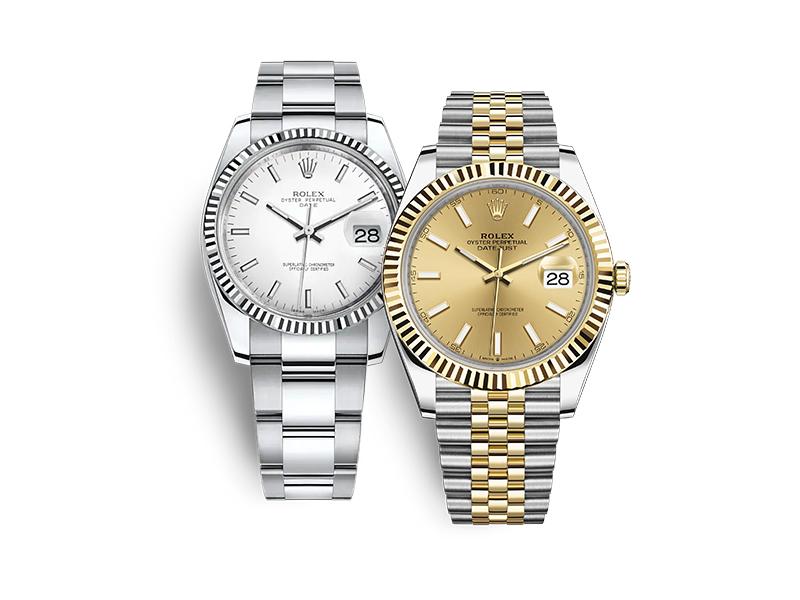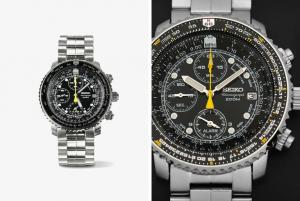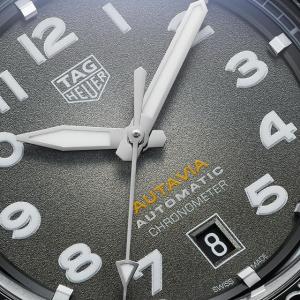Rolex Datejust 41: The Lowdown on the Classic Gentleman’s Watch

The Rolex Oyster Perpetual Datejust 41 — or simply Datejust 41 — spans Rolex’s legacy in one elegant timepiece. Overall, this watch encapsulates the brand’s philosophy and heritage in one. However plain and simple it looks, it surely embodies the essence of accuracy and sophistication.
The watch comes in various configurations that make it truly a gentleman’s preference. It comes in various material makeup, as well as colours. The most popular you’ll see on the market today is perhaps the References 126333 and 126334. However big their differences are in price points, they all carry the iconic Datejust genetic code.
So, what exactly makes this watch every gentleman’s favourite choice? Let’s find out.
Rich History of the Rolex Datejust
In 1905, Alfred Davis and his brother-in-law Hans Wilsdorf founded Wilsdorf and Davis in London. It eventually became Rolex in 1908. At the time, Rolex focused on importing Swiss movements from Hermann Aegler to England. They used those movements in cases made by Dennison and other manufacturers. Rolex assembled these watches and sold them to various sellers who then put their own brand names on the dial.
As Wilsdorf register the name Rolex, he also opened an office in La Chaux-de-Fonds in Switzerland. Wilsdorf himself made the brand as such so that it will be easy to pronounce. It was also an onomatopoeia of a watch being wound. That was only the beginning of Rolex’s journey toward Swiss precision.
A Class-A Chronometer
It was in 1914 that Kew Observatory recognised a Rolex watch with a Class A precision certificate. Chiefly awarded exclusively to marine chronometers, Rolex’s feat put the brand’s name on the map. However, like any other company during the First World War, Rolex met with hardships along the way. Wilsdorf left England in 1919 due to the post-war taxes demanded from luxury imports. The economy also greatly affected the costs of exporting silver and gold used for the watch cases. Due to the crisis, Wilsdorf brought the company to Geneva, Switzerland.

The Oyster Case
Moving the company to Geneva wasn’t the solution to all their worries. Rolex still had to solve a technical concern in their watches. Back then, Rolex watches weren’t all that robust however accurate they were. Dust and moisture still infiltrated their cases through the dial and crown. This resulted in the damaging of the movement that made the whole watch work in the first place. So, as a solution, Rolex produced their first waterproof and dustproof wristwatch in 1926. The brand aptly named it the Oyster. The Oyster case featured a screwed-down bezel, caseback, and window crown to the middle case that gave the movement optimum protection from moisture and dust.
The case was so revolutionary that a lot of people still weren’t ready for its existence. A lot still remained sceptical of the waterproof, dustproof case. So, Rolex submerged Oyster-cased watches in aquariums as a means of a display to prove its water resistance. To further the Oyster’s prowess, British swimmer Mercedes Gleitze swam across the English Channel accompanied by an Oyster watch. Gleitze also became the brand’s first ambassador. In celebration of her successful feat and Oyster’s participation, Rolex published a full-page advertisement on the front page of the Daily Mail. It told the story of the successful 10-hour swim of the swimmer and Oyster’s role in the feat.
The patented case can still be found in today’s Rolex watches but with improvements here and there.

The Perpetual Rotor
Innovation isn’t new to the brand. After the successful marketing of the patented Oyster case, the brand went on to deliver greater inventions. In 1931, Rolex patented the Perpetual rotor. It’s a self-winding mechanism that relies on gravity to move accordingly. The semi-circular plate became popular among patrons. In fact, the first Rolex Perpetual watch is the first wristwatch to use a 360° winding rotor. This became the basis of all automatic watches we know today. With the Perpetual’s birth, the Oyster watch later became known as the Rolex Oyster Perpetual.
The Evolution of the Datejust
In 1945, Rolex celebrated its 40th founding anniversary. This prompted the company to look back on all their major innovations and put them all in one watch. Thus, the Datejust. As an amalgamation of everything great about Rolex, the Datejust became one of the best-selling Rolex watches ever. While there are more popular models such as the Rolex Daytona or Rolex Submariner, the Datejust is as lowkey as it is trusty.

The First Rolex Oyster Perpetual Datejust Ref. 4467
The first Datejust reference 4467 is a self-winding chronometer watch with a date display on the dial; hence, its name. Not only does it stand out with an entirely 18K yellow gold case and bracelet, but it also has a unique fluted bezel. Contrary to others’ beliefs, it didn’t have the word “Datejust” on the slightly curved dial. However, it’s the first watch to ever have the five-piece link metal Jubilee bracelet. It’s also the first model as such encased in an Oyster.
Reference 4467 had quite a flaw to its existence. While it boasts breaking the mould of mostly time-only watches at the time, it wasn’t as efficient as people needed it to be. The date indication takes quite some time to change over to the next day. It took Rolex 10 years to fix this inefficient flaw. In 1955, the brand reissued the watch with a more instantaneous mechanism, plus a cyclops magnifier for the date.

Changes Through the Years
Many years later and after two more successful Datejust watches, Rolex improved the watch’s movement. They changed its calibre to the Calibre 1065. It was a smaller calibre that allowed for a flatter caseback rather than a slightly arched previous version. It was also during that time that the two-tone or Rolesor versions of the watch came alongside a smaller Lady Datejust.
In the 1970s, Rolex introduced a new in-house calibre, the 3035. Datejust watches with references 160XX had this movement. The new calibre had a quick-set function allowing the date to be adjusted, independent from the watch’s hands. In the past movements, the date may only be adjusted through 2 dial evolutions of the hour hand. The new calibre boasts a specific position wherein the date may be set forwards and backwards without cycling the hour hand.
With the effects of the Quartz Crisis in the ’60s to ’70s, Rolex found ways by joining forces with Swiss brands to develop a quartz calibre. After a five-year journey — despite sharing provenance with a Beta 21 quartz movement — Rolex still developed a quartz movement of their own, released in 1977. The ref. 17000 Oysterquartz Datejust featured the 5035 quartz movement.

The Launch of Datejust II
In the past, the Datejust was only offered in 36mm diametres. However, the market demanded bigger watches in the dawn of the new millennium. So, Rolex offered a bigger Datejust at 41mm and called it the Datejust II. The Rolex Datejust II (ref. 1163XX) had a new dial style and came in either steel or Rolesor built. Patrons also had the choice between a domed or fluted bezel. It was sold only in the Oyster bracelet. However, the watch wasn’t as successful as Rolex had imagined. So, they discontinued the watch’s production in 2016. Seemingly so, the brand repacked the Datejust II and then came the Datejust 41.
The Birth of the Rolex Datejust 41
When the Datejust 41 launched, it came only in Rolesor composition or a steel-and-white gold combination. However, in 2017, Rolex also launched a steel-and-white gold version that most people loved. Rolex also made it possible to have the Datejust 41 in a steel-only version that was much more affordable than other choices.
The Datejust 41 had the same overall DNA as its predecessors, albeit larger at 41mm — therefore, the name. The watch came in an Oyster case with a water-resistance of up to 100 metres or 330 feet. The Oyster case would already be improved by the Twinlock technology of Rolex that added twice the waterproof system it already had. The screwed-down winding crown ensured the reliability of the Twinlock system. The crystal, still equipped with a Cyclops lens at 3 o’clock for the date window, was sapphire.

Oyster or Jubilee
Patrons may also choose between a five-piece link Jubilee bracelet and a flat three-piece link Oyster bracelet. For reference, the Jubilee was the very bracelet of the first Datejust watch. It would, therefore, be more historically accurate to own one. However, both bracelets have the new concealed attachment system underneath the bezel. This makes the bracelet look like it’s seamlessly connected to the case. Rolex’s Easylink extension allowed for the bracelet to extend up to 5mm.

Composition
Today, the Datejust 41 may be configured to your heart’s desire on Rolex’s website. You may choose from various model options. There’s the much affordable (yet still quite pricey) option that is an Oystersteel case and bracelet that is the Reference 126300. You may also pick a combination of an Oystersteel and white gold or Reference 126334. Opting for a classic, the Reference 126333 features a Rolesor (Oystersteel and yellow gold) design. For a different feel, you may pick Reference 126331, also a Rolesor, with an Oystersteel and everose gold composition.
Each model has the option for a fluted bezel or not. References 126300 and 126334 have the option for a fluted white gold bezel. Meanwhile, Reference 126333 has the option for a fluted yellow gold bezel. Subsequently, Reference 126331 has an option for an everose gold fluted bezel.

Dial Design
There are various dial design options for all the models of the Datejust 41. You may choose from either black, slate, champagne, silver or white. If you’re feeling a lot fancier, you may also opt for version with diamond indexes with the dial colour in the same dial colour options to match your model of choice. Each colour has a sunray finish that adds to its elegance. Other dial designs have rectangular 18K gold indexes to keep them from tarnishing easily. Meanwhile, other dial designs feature Roman numeral hour markers with the same Chromalight display for all designs.

Movement
Powering through each Rolex Datejust 41 watch is the Calibre 3235. The calibre is an in-house self-winding movement that has 14 patents under its name in total. Among its many features is the Chronergy escapement that makes the watch more energy-efficient versus other movements. It has 70 hours of power reserve and accuracy of -2/+2 seconds per day.
The movement is not only efficient in power usage but also insensitive to magnetism, making it accurate despite environmental pressure changes. That’s all thanks to the Paramagnetic blue Parachrom hairspring. It also has a high-performing Paraflex shock absorber. All of these features were validated by a Superlative Chronometer certification in 2015.
Pricing
The Datejust 41 is, as expected, quite pricey. It is a Rolex, after all. You may expect reference 126300 to cost from about 8,500 USD to 10,000 USD, depending on your bezel of choice. Meanwhile, the most expensive Datejust 41 could cost from around 14,000 USD to 20,000 USD. This, of course, depends on your bezel, bracelet, and dial of choice. The diamond-set dial would cost a lot more, especially if it’s in a mother of pearl. Jubilee bracelets cost quite more than the Oyster bracelet as well.
It should be remembered that the Datejust 41 is a popular model that makes it susceptible to counterfeit. Make sure to double-check your retailer before purchasing one. But since it’s a popular model, secondhand models could cost around the same as its original retail price.
Final Thoughts
Rolex Datejust watches are history and innovation right on your wrist. That’s probably one of the greatest selling points of the watch that makes it such a special model. With its size increased with the Datejust 41, it makes for such a strong case and a statement piece. As the watch costs a lot more than other automatic watches in the market despite it having a simpler design, it’s no secret that it remains to be a reliable watch. It offers a lot more than just style but dependability that you can’t get from just any other watch.
It’s a dress watch, as well as a sports watch for the recreational enthusiast. You may wear it just about anywhere and anytime without having to worry if it fits your ensemble. It blends just well with an understated design but stands out when necessary. Its simplicity only means versatility and that’s something priceless even for a Rolex.
Want to learn more about Rolex and their vintage offers? Check out our guide on purchasing a vintage Rolex watch.


